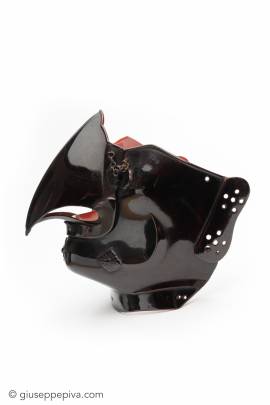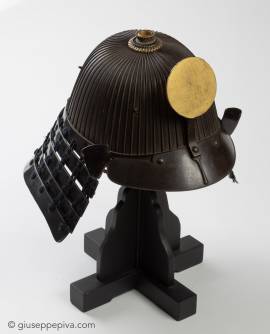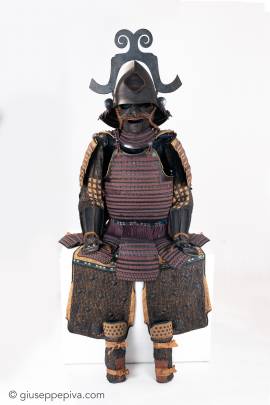A half-face samurai armor maskEdo period, circa 1700 Lacquered iron; the nose detachable. In Hindu mythology, the Karura was a sacred bird that ate a poisonous snake. When this deity was taken into Buddhism, it became one of the gods who guard the Buddhist faith. This figure is also one of the fourteen characters in the gigaku, a religious dance-drama that was performed for the Japanese royal court at Buddhist temple ceremonies from the 7th to the 10th century. Armor masks modelled after the gigaku mask of Karura started to appear during the late Muromachi period and show specific...
WORKS FOR SALE
Suji-bachi kabuto
A russet iron samurai helmetDATEMid Edo period, 18th centuryMEDIUMIronSIGNJōshū jū Saotome Ieharu A rare 62-plate kabuto. The plates are joined with hammered rivets, invisible from the outside. In the interior, the “Saotome-byo" is visible, as a typical feature of the Saotome armor makers.Each plate is connected with seven rivets and shows an embossed shape that reveals a very strong construction of the whole kabuto that can be very effective against bullets: each plate is in fact strongly curved but then flatten under the next one; as a result, the bowl...
Early Edo period (1615–1867) DescriptionThis authentic samurai armor is a tosei gusoku (modern armor), which was common throughout the time period but had certain significant innovations added. The combination of colors and ornamentation is stunning, as is typical of Inaba clan armour, with a rare purple binding (murasaki) used solely by the most senior members of the military aristocracy. The helmet, which is adorned with an amazing and extremely rare kashiradate hooked on the sides, is unquestionably the element that seems to take center stage. This element represents a kotoji,...
Copyright © 2016 - giuseppe piva - VAT: 05104180962










